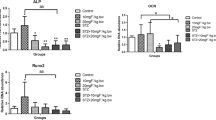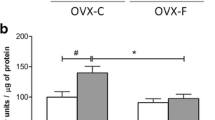Abstract
Studies on the role of insulin and insulin receptor (InsR) in the process of skeletal fluorosis, especially in osteogenic function, are rare. We evaluated the effect of increasing F− doses on the marker of bone formation, serum insulin level and pancreatic secretion changes in vivo and mRNA expression of InsR and osteocalcin (OCN) in vitro. Wistar rats (n = 50) were divided into two groups, i.e. a control group and fluoride group. The fluoride groups were treated with fluoride by drinking tap water containing 100 mg F−/L. The fluoride ion-selective electrode measured the fluoride concentrations of femurs. The alkaline phosphatase (ALP), OCN, insulin and glucagon of serum were tested to observe the effect of fluoride action on them. Meantime, the pancreas pathological morphometry analysis via β cells stained by aldehyde fuchsin showed the action of fluoride on pancreas secretion. MC3T3-E1 cells (derived from newborn mouse calvaria) were exposed to varying concentrations and periods of fluoride. The mRNA expression of InsR and OCN was quantified with real-time PCR. Results showed that 1-year fluoride treatment obviously stimulated ALP activity and OCN level along with increase of bone fluoride concentration of rats, which indicated that fluoride obviously stimulated osteogenic action of rats. In vitro study, the dual effect of fluoride on osteoblast function is shown. On the other hand, there was a significant increase of serum insulin level and a general decrease of glucagon level, and the histomorphometry analysis indicated an elevated insulin-positive area and increase in islet size in rats treated with fluoride for 1 year. In addition, fluoride obviously facilitated the mRNA expression of InsR in vitro. To sum up, there existed a close relationship between insulin secretion and fluoride treatment. The insulin signal pathway might be involved in the underlying occurrence or development of skeletal fluorosis.







Similar content being viewed by others
References
Mousny M, Omelon S, Wise L et al (2008) Fluoride effects on bone formation and mineralization are influenced by genetics. Bone 43:1067–1074
Li G, Ren L (1997) Effects of excess fluoride on bone turnover under conditions of diet with different calcium contents. Zhonghua Bing Li Xue Za Zhi 26:277–280
Hill PA (1998) Bone remodeling. Br J Orthod 25:101–107
Ferron M, Wei J, Yoshizawa T et al (2010) Insulin signaling in osteoblasts integrates bone remodeling and energy metabolism. Cell 142:296–308
Fulzele K, DiGirolamo DJ, Liu Z et al (2007) Disruption of the insulin-like growth factor type 1 receptor in osteoblasts enhances insulin signaling and action. J Biol Chem 282:25649–25658
Fulzele K, Riddle RC, Digirolamo DJ et al (2010) Insulin receptor signaling in osteoblasts regulates postnatal bone acquisition and body composition. Cell 142:309–319
Ng KW (2011) Regulation of glucose metabolism and the skeleton. Clin Endocrinol (Oxf) 75:147–155
Xu H, Zhou YL, Zhang XY et al (2010) Activation of PERK signaling through fluoride-mediated endoplasmic reticulum stress in OS732 cells. Toxicology 277:1–5
Xu H, Liu QY, Jm Z et al (2010) Elevation of PTH and PTHrp induced by excessive fluoride in rats on a calcium-deficient diet. Biol Trace Elem Res 137:79–87
Goltzman D (2002) Discoveries, drugs and skeletal disorders. Nat Rev Drug Discov 10:784–796
Choubisa SL, Choubisa L, Choubisa DK (2001) Endemic fluorosis in Rajasthan. Indian J Environ Health 43:177–189
Dhar V, Bhatnagar M (2009) Physiology and toxicity of fluoride. Indian J Dent Res 20:350–355
Nair M, Belak ZR, Ovsenek N (2011) Effects of fluoride on expression of bone-specific genes in developing Xenopus laevis larvae. Biochem Cell Biol 89:377–386
Vicente-Rodríguez G, Ezquerra J, Mesana MI et al (2008) Independent and combined effect of nutrition and exercise on bone mass development. J Bone Miner Metab 26:416–424
Ammann P, Rizzoli R, Caverzasio J et al (1998) Fluoride potentiates the osteogenic effects of IGF-I in aged ovariectomized rats. Bone 22:39–43
Shashi A, Bhardwaj M (2011) Study on blood biochemical diagnostic indices for hepatic function biomarkers in endemic skeletal fluorosis. Biol Trace Elem Res 143:803–814
Susheela AK, Jethanandani P (1996) Circulating testosterone levels in skeletal fluorosis patients. J Toxicol Clin Toxicol 34:183–189
Ruzicska E, Poór G (2011) Diabetes and bone metabolism. Orv Hetil 152:1156–1160
wa H, Kiyomiya K et al (2000) Fluoride-induced ultrastructural changes in exocrine pancreas cells of rats: fluoride disrupts the export of zymogens from the rough endoplasmic reticulum (rER). Arch Toxicol 73:611–617
Rigalli A, Ballina JC, Roveri E et al (1990) Inhibitory effect of fluoride on the secretion of insulin. Calcif Tissue Int 46:333–338
Trivedi N, Mithal A, Gupta SK et al (1993) Reversible impairment of glucose tolerance in patients with endemic fluorosis. Fluoride Collaborative Study Group. Diabetologia 36:826–828
Tokar VI, Zyrianova VV, Shcherbakov SV (1992) Chronic effect of fluorides on the status of the pancreatic insular apparatus of workers. Gig Sanit 11–12:42–44
Acknowledgments
This work was supported by a grant for skeletal fluorosis research from the National Natural Science Foundation of China (81072249) and the Fundamental Research Funds for the Central Universities (450060481931).
Author information
Authors and Affiliations
Corresponding authors
Rights and permissions
About this article
Cite this article
Hu, Cy., Ren, Lq., Li, Xn. et al. Effect of Fluoride on Insulin Level of Rats and Insulin Receptor Expression in the MC3T3-E1 Cells. Biol Trace Elem Res 150, 297–305 (2012). https://doi.org/10.1007/s12011-012-9482-x
Received:
Accepted:
Published:
Issue Date:
DOI: https://doi.org/10.1007/s12011-012-9482-x




